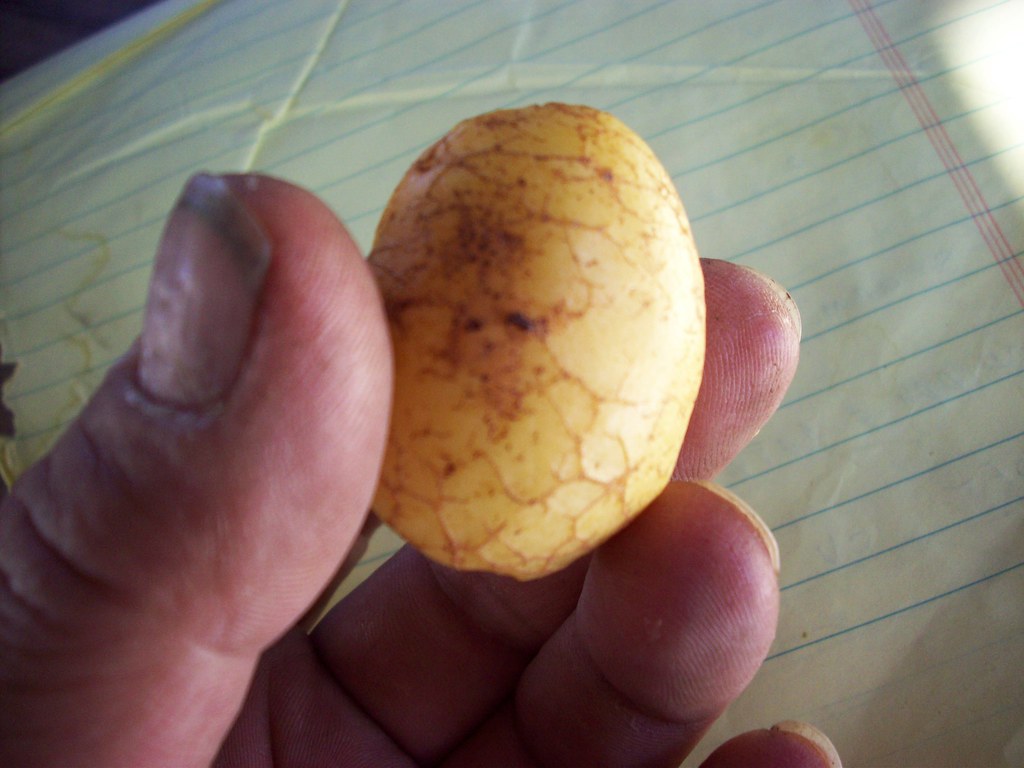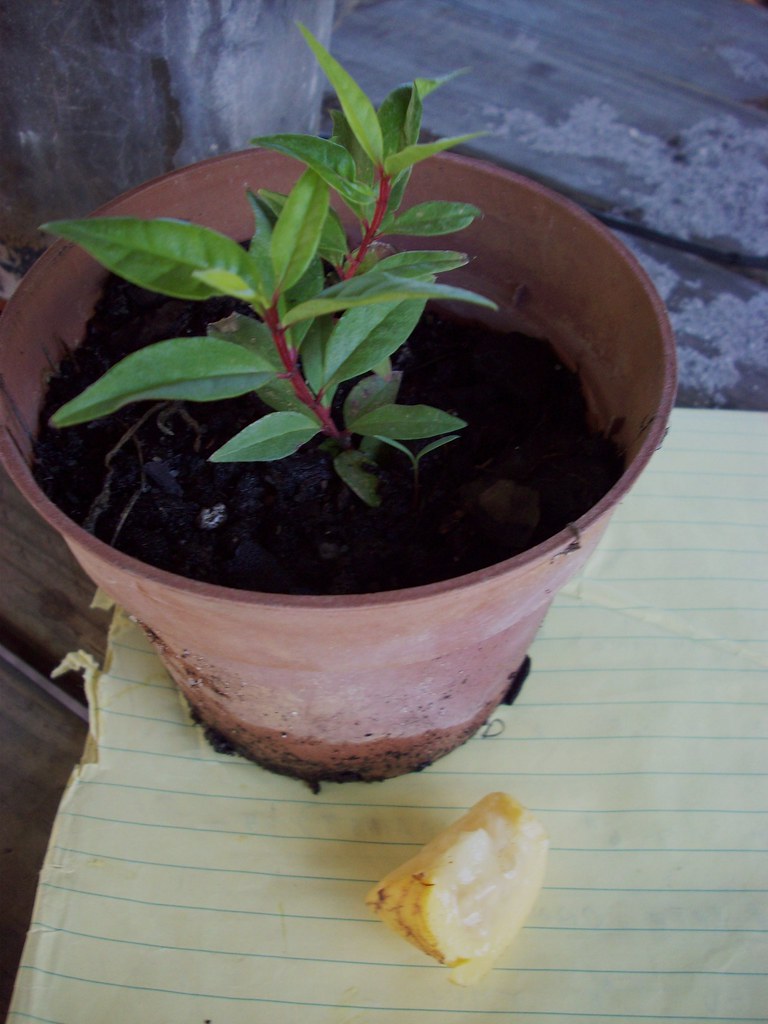

 Family: Myrtaceae •
Family: Myrtaceae •
Genus: Psidium •
Species: friedrichsthalianum •
Country of Origin: Central and South America •
Common Names: Costa Rican Guava, Cas •
This is the best guava I've tasted to date. It's sour!!! It has a wonderful taste similar to Pineapple Guava Feijoa sellowiana. It is an attractive tree, just look at the red stems and petioles. It ultimately can reach 35 feet. The white flowers are fragrant and typical of this genus. This tree is susceptible to cold. (Update 07-22-2010) My three foot tree made it through < 28 °F this winter. This species is a lot more cold hardy than most sources have stated in the past including Morton. It also grows quite vigorously here in South Florida.
here's a little more info not much out there on this species
http://www.hort.purdue.edu/newcrop/morton/costa_rican_guava.html

Costa Rican Guava Psidium friedrichsthalianum by Eric Bronson is licensed under a Creative Commons Attribution-Noncommercial-No Derivative Works 3.0 United States License.
Based on a work at www.flickr.com
Saturday, February 7, 2009
Costa Rican Guava Psidium friedrichsthalianum
Posted by Eric Bronson at 1:02 PM 3 comments
Labels: myrtaceae, tropical fruits
Thursday, February 5, 2009
Guava Psidium guajava 'Ruby x Supreme' 10.40

Family: Myrtaceae •
Genus: Psidium •
Species: guajava •
Country of Origin: Central America •
Common Names: Guava 'Ruby x Supreme' 10.40 •
This is a really nice hybrid sweet & delicious and it has a thick enough skin to keep out fruit fly larvae. This shows how important selection and hybridization can be for a successful crop.
Guava is a small tree reaching 33 feet. The trunk is highly ornamental and leaves are aromatic. With beautiful faintly fragrant white flowers, borne singly or in small clusters in the leaf axils, are 1 in (2.5 cm) wide, with 4 or 5 white petals which are quickly shed, and a prominent tuft of perhaps 250 white stamens tipped with pale-yellow anthers.
The fruits are typically round, ovoid or pear-shaped and exuded a musky odor when ripe.
Guava is very adaptable and it will do well in dry and humid climates. But it is not cold hardy and may die back to the ground with temperatures below 26°FFood Value Per 100 g of Edible Portion* Calories 36-50 Moisture 77-86 g Crude Fiber 2.8-5.5 g Protein 0.9-1.0 g Fat 0.1-0.5 g Ash 0.43-0.7 g Carbohydrates 9.5-10 g Calcium 9.1-17 mg Phosphorus 17.8-30 mg Iron 0.30-0.70 mg Carotene (Vitamin A) 200-400 I.U. Thiamine 0.046 mg Riboflavin 0.03-0.04 mg Niacin 0.6-1.068 mg Vitamin B3 40 I.U. Vitamin G4 35 I.U.
*Analyses of whole ripe guavas.
from 'Fruit of Warm Climates' Julia F. Morton

Guava Psidium guajava 'Ruby x Supreme' 10.40 by Eric Bronson is licensed under a Creative Commons Attribution-Noncommercial-No Derivative Works 3.0 United States License.
Based on a work at www.flickr.com
Posted by Eric Bronson at 11:59 AM 4 comments
Labels: myrtaceae, tropical fruits
Tuesday, February 3, 2009
Top 100 Botany Blogs
I found out today my blog has been featured on the Top 100 Botany Blogs website. I'm Honored!!!
Anyway, I encourage you to check out this website. It features tons of good stuff.
http://www.online-college-blog.com/index.php/uncategorized/top-100-botany-blogs/
Posted by Eric Bronson at 6:29 PM 3 comments
Labels: top 100
Sunday, February 1, 2009
Climate Change and Tropical Fruits in South Florida
This is the article I wrote for this months RFVC of Broward County newsletter.
I’m not a climatologist or a meteorologist, but it doesn’t take one to realize it is getting warmer. Especially if you were born here or have lived here thirty or more years like me. How will this affect a rare fruit grower you ask? Well, we know that Cherimoya (Annona cherimola) and Pineapple Guava (Feijoa sellowiana) prefer a more temperate climate. Could our beloved Lychee (Litchi chinensis), Longan (Dimocarpus longan) and Mango (Mangifera indica) trees range further north. Could fruits like Rambutan (Nephelium lappaceum), Mangosteen (Garcinia mangostana) and Durian (Durio zibethinus) eventually grow in South Florida? Unfortunately, most of the real good research was done in the 50’s and 60’s and most of today’s books and websites that claim to be authorities only regurgitate information from the one good source. “Fruits of Warm Climates” Julia F. Morton (1987) All of the “experts” say it can’t be done. I say more research is needed. Mr. Bill Whitman grew and fruited Mangosteen, Rambutan, et.al at his home in Bal Harbour, FL granted it is a protected area with the ocean on one side and the inter-coastal waterway on the other. A recent study by NASA showed that wetlands stay warmer than developed areas and wetland restoration is already happening in South Florida.(1) Could this give us the buffer we need to grow these species? Botanists developed a spray that, when misted over a plant, will help it endure temperatures 2.2 to 9.4 degrees Fahrenheit colder than it would without the spray, depending upon the species. The spray, called Freeze-Pruf, reduces the freezing point of water inside the tissues of the plant by means of a mixture that combines five ingredients in a water-based spray formula. One spray works for four to six weeks, lowering the temperature at which damage first becomes noticeable as well as the temperature that would normally kill the plant.(2) During my research for this article I have discovered we only have really cold temperatures in four months November, December, January and February, with the worst temps in January and February. According to the records I researched, it has dropped below 32°f twenty-five times in the last one hundred years and out of those seventeen were before 1980.(3) So cold temperatures don’t happen very often. It is my opinion that more work needs to be done on selection of varieties that are more tolerant of cold. Experiments like these aren’t for an average grower. However, some of us, in the spirit of Bill Whitman & Julia Morton, have the patience to try our hand at it. As our climate changes we need to continue to have trials of each of these species. I’m already recording daily highs, lows and rainfall. Also, I’m keeping records of damage caused by the cold and I encourage you to do so as well. I challenge all you rare fruit fans to try your hand at growing rare fruit trees you thought weren’t possible, or something that is truly rare. I’ll share some of these species in my next article.
(1)http://www.nasa.gov/vision/earth/environment/wetland_freeze.html
(2)http://physicsnow.net/dbis/stories/2008/18130.html
(3)http://www.srh.noaa.gov/mfl/localdata.php
References;
Freeze Damage to Tropical Fruit Trees in 1940 S. J. Lynch
Freeze Damage to Tropical Fruit Trees in 1957-58 R. Bruce Ledin
Freeze Damage to Tropical Fruit Trees in 1977 C. W. Campbell, R. J. Knight, N. L. Zareski
Freeze Protection of Tropical Fruit Crops 2008 Dr. Jonathan H. Crane
Posted by Eric Bronson at 4:23 PM 1 comments
Labels: monthly newsletter article
